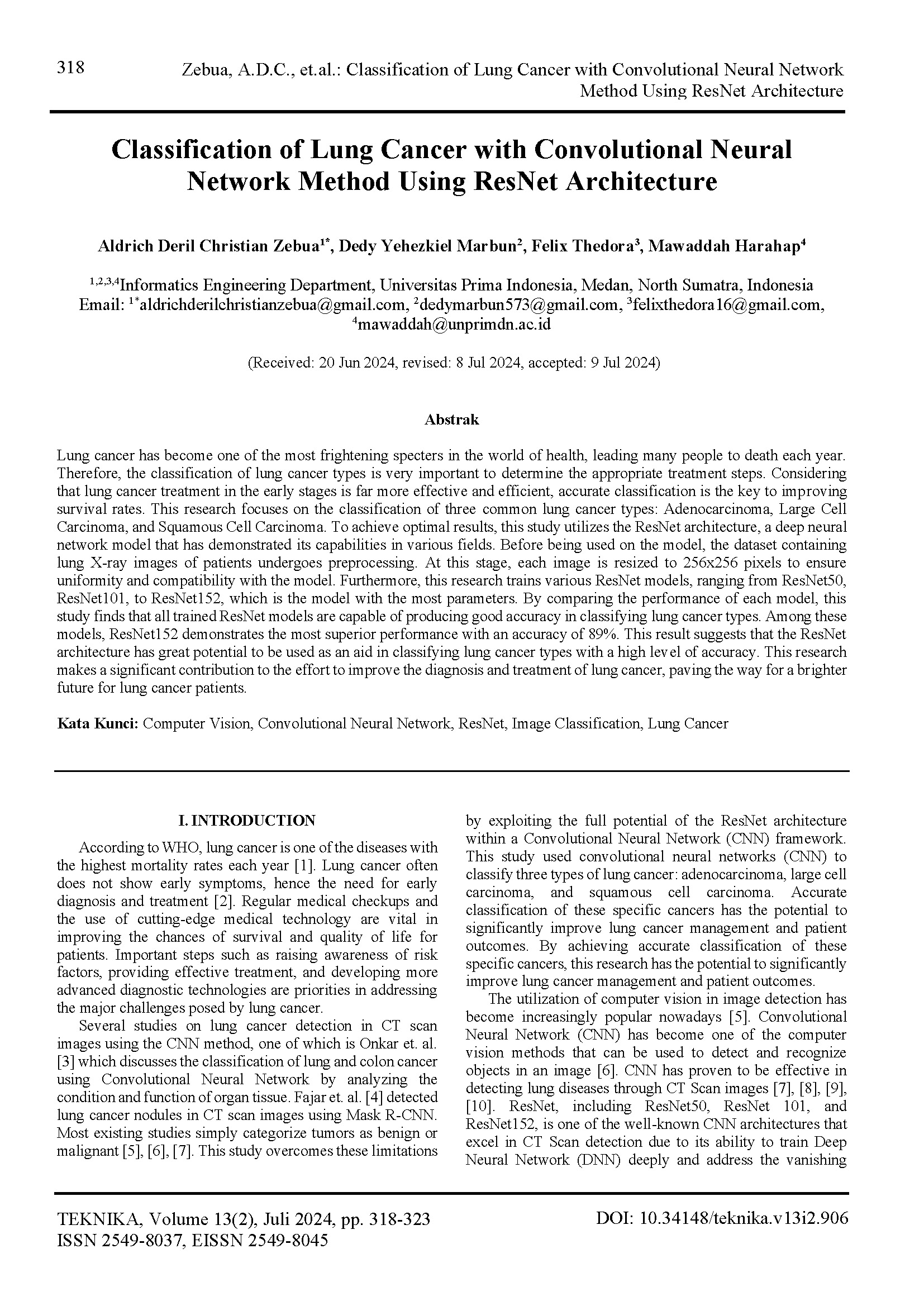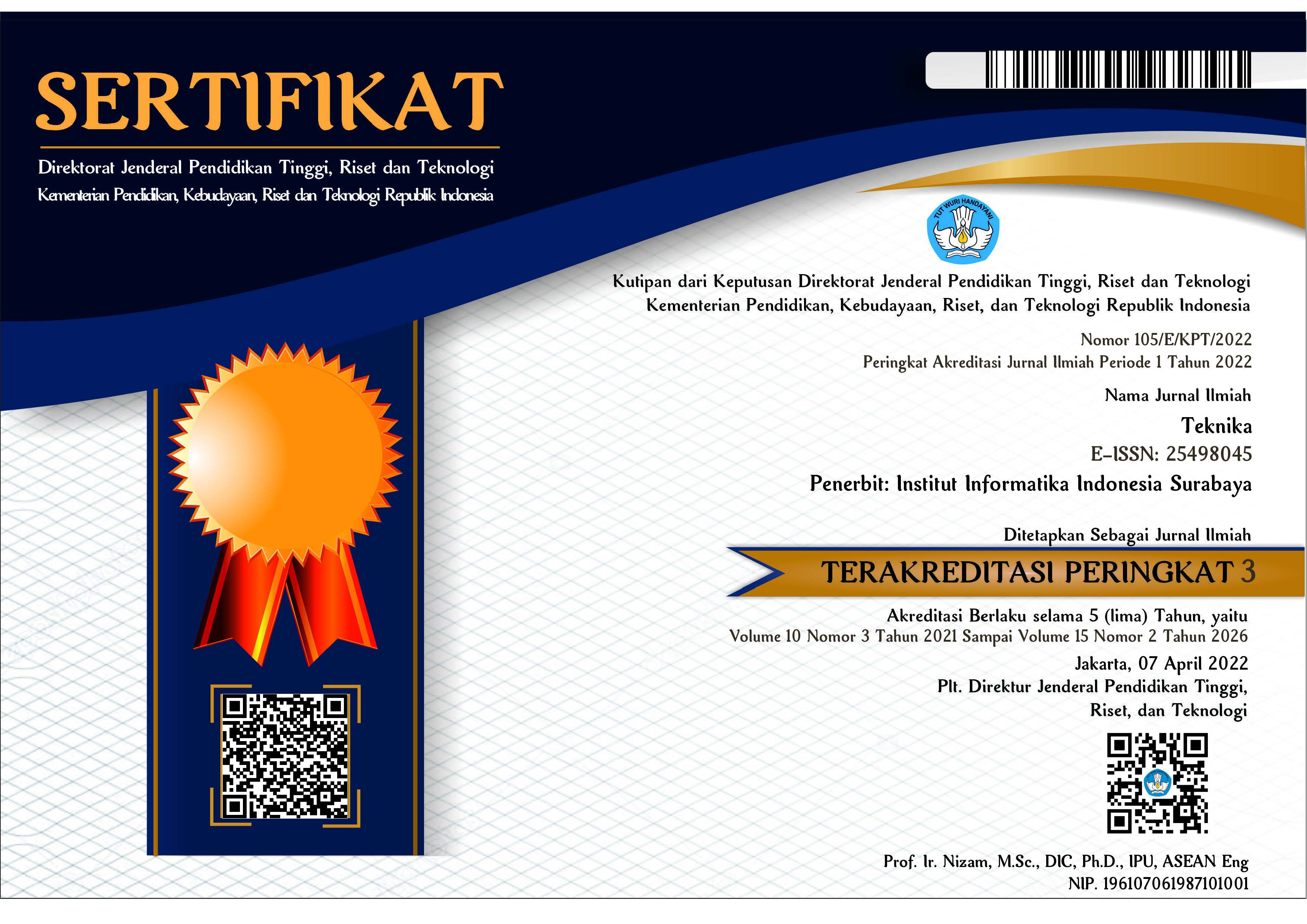Classification of Lung Cancer with Convolutional Neural Network Method Using ResNet Architecture
DOI:
https://doi.org/10.34148/teknika.v13i2.906Keywords:
Computer Vision, Convolutional Neural Network, ResNet, Image Classification, Lung CancerAbstract
Lung cancer has become one of the most frightening specters in the world of health, leading many people to death each year. Therefore, the classification of lung cancer types is very important to determine the appropriate treatment steps. Considering that lung cancer treatment in the early stages is far more effective and efficient, accurate classification is the key to improving survival rates. This research focuses on the classification of three common lung cancer types: Adenocarcinoma, Large Cell Carcinoma, and Squamous Cell Carcinoma. To achieve optimal results, this study utilizes the ResNet architecture, a deep neural network model that has demonstrated its capabilities in various fields. Before being used on the model, the dataset containing lung X-ray images of patients undergoes preprocessing. At this stage, each image is resized to 256x256 pixels to ensure uniformity and compatibility with the model. Furthermore, this research trains various ResNet models, ranging from ResNet50, ResNet101, to ResNet152, which is the model with the most parameters. By comparing the performance of each model, this study finds that all trained ResNet models are capable of producing good accuracy in classifying lung cancer types. Among these models, ResNet152 demonstrates the most superior performance with an accuracy of 89%. This result suggests that the ResNet architecture has great potential to be used as an aid in classifying lung cancer types with a high level of accuracy. This research makes a significant contribution to the effort to improve the diagnosis and treatment of lung cancer, paving the way for a brighter future for lung cancer patients.
Downloads
References
W. H. Organization, “Lebih dari 100 alasan untuk berhenti merokok,” who.int, 2021. https://www.who.int/indonesia/news/campaign/world-no-tobacco-day-2021/more-than-100-reasons (accessed May 07, 2024).
P. K. RI, “Waspadai Gejala Kanker Paru,” p2ptm.kemkes.go.id, 2019. https://p2ptm.kemkes.go.id/infographic-p2ptm/penyakit-kanker/waspadai-gejala-kanker-paru (accessed May 07, 2024).
K. Singh, Onkar & Kashyap, kanchan lata & Singh, “Lung and Colon Cancer Classification of Histopathology Images Using Convolutional Neural Network,” SN Computer Science, 2024.
F. A. Hermawati and M. Imam Safii, “Sistem Deteksi Keganasan Kanker Paru-Paru pada CT Scan dengan Menggunakan Metode Mask Region-based Convolutional Neural Network (Mask R-CNN),” Konf. Nas. Ilmu Komput., pp. 193–197, 2021.
F. Marpaung, F. Aulia, and R. C. Nabila, Computer Vision Dan Pengolahan Citra Digital. 2022.
A. S. Adi, “Konsep Dasar Convolutional Neural Network (CNN),” warstek.com, 2024. https://warstek.com/convolutional-neural-network/ (accessed May 13, 2024).
D. Rini Anggraini, “Menggunakan Deep Learning Convolution Neural Network - Indonesian of Health Information Management Journal (INOHIM),” INOHIM, vol. 10 No. 2, 2022.
D. Asmaa Abbas, “DETEKSI CORONAVIRUS DISEASE PADA X-RAY DAN CT-SCAN PARU MENGGUNAKAN CONVOLUTIONAL NEURAL NETWORK,” Online J. Unja, no. Deteksi Coronavirus Disease pada X-Ray dan CT-Scan Paru Menggunakan Convolutional Neural Network, 2020.
M. R. Permana, “Convolutional Neural Networks dalam Analisis Citra Medis,” Konstelasi Konvergensi Teknol. dan Sist. Inf., vol. 2, No. 2, 2022.
S. Bonechi, “Segmentasi Aorta 3D CT Images Berbasis 2D Convolutional Neural Networks,” Electronics, vol. 10, N0. 20, 2021.
Datagen, “ResNet: The Basics and 3 ResNet Extensions,” datagen.tech. https://datagen.tech/guides/computer-vision/resnet/ (accessed May 13, 2024).
T. M. S. Hospitals, “CT Scan Thorax untuk Deteksi Kanker Paru-Paru, Kenali Manfaat dan Prosedurnya,” siloamhospitals.com, 2023, [Online]. Available: https://www.siloamhospitals.com/informasi-siloam/artikel/ct-scan-thorax-untuk-kanker-paru
A. H. Krist et al., “Screening for Lung Cancer: US Preventive Services Task Force Recommendation Statement,” JAMA - J. Am. Med. Assoc., vol. 325, no. 10, pp. 962–970, 2021, doi: 10.1001/jama.2021.1117.
A. C. Society, “Lung Cancer Screening Guidelines,” www.cancer.org, 2024.
N. C. Institute, “Lung Cancer—Patient Version,” www.cancer.gov. https://www.cancer.gov/types/lung (accessed May 13, 2024).
E. S. F. M. Oncology, “Lung Cancer Screening with Low-Dose CT Could Be Cost Effective,” esmo.org. https://www.esmo.org/oncology-news/archive/lung-cancer-screening-with-low-dose-ct-could-be-cost-effective (accessed May 13, 2024).
M. Rejeki and E. N. Pratiwi, “Diagnosis dan Prognosis Kanker Paru, Probabilitas Metastasis dan Upaya Prevensinya,” Proceeding of The URECOL, vol. 1, no. 1, pp. 73–78, 2020.
Andryanto, “Deteksi Kanker Paru-paru pada CT Scan Menggunakan ResNet dan Transfer Learning,” J. Ilm. Tek. Elektro, vol. 14, No. 2, 2023.
R. Anggraini, “Klasifikasi Nodul Paru-paru pada CT Scan Menggunakan ResNet dan Deep Learning,” J. Sist. Cerdas, vol. 13, No. 2, 2022.
D. Anggraini, “Segmentasi Tumor Paru-paru pada CT Scan Menggunakan ResNet dan U-Net,” J. Sains dan Teknol. Komput., vol. 12, No. 1, 2022.
D. Gunawan and H. Setiawan, “Convolutional Neural Network dalam Citra Medis,” KONSTELASI Konvergensi Teknol. dan Sist. Inf., vol. 2, no. 2, pp. 376–390, 2022, doi: 10.24002/konstelasi.v2i2.5367.
W. Du, X. Luo, and M. Chen, “A Practical Deep Learning Model in Differentiating Pneumonia-Type Lung Carcinoma from Pneumonia on CT Images: ResNet Added with Attention Mechanism,” J. Oncol., vol. 2022, 2022, doi: 10.1155/2022/8906259.
R. Wightman, H. Touvron, and H. Jégou, “ResNet strikes back: An improved training procedure in timm,” pp. 1–22, 2021, [Online]. Available: http://arxiv.org/abs/2110.00476
Z. Niswati, R. Hardatin, M. N. Muslimah, and S. N. Hasanah, “Perbandingan Arsitektur ResNet50 dan ResNet101 dalam Klasifikasi Kanker Serviks pada Citra Pap Smear,” Fakt. Exacta, vol. 14, no. 3, p. 160, 2021, doi: 10.30998/faktorexacta.v14i3.10010.
U. Khultsum, F. Sarasati, and G. Taufik, “Penerapan Metode Mobile-Net Untuk Klasifikasi Citra Penyakit Kanker Paru-Paru,” JURIKOM (Jurnal Ris. Komputer), vol. 9, no. 5, p. 1366, 2022, doi: 10.30865/jurikom.v9i5.4918.
A. Vierisyah and R. M. Fajri, “Klasifikasi Kanker Paru Paru Menggunakan Cnn Dengan 5 Arsitektur,” J. Intell. Networks IoT …, no. 629, pp. 84–91, 2023, [Online]. Available: https://ejournal.uigm.ac.id/index.php/JINIG/article/download/3643/2054
T. D. Putra, E. Utami, and M. P.Kurniawan, “Klasifikasi penderita kanker Paru Paru Menggunakan Algoritma Artificial Neural Network (ANN),” Explore, vol. 12, no. 2, p. 13, 2022, doi: 10.35200/explore.v12i2.568.
P. Pratiwi, D. Dwifa, A. Desiani, A. Amran, and B. Suprihatin, “Klasifikasi Penyakit Kanker Paru-Paru Menggunakan Algoritma Naïve Bayes dan Iterative Dichotomizer 3 (ID3),” Electr. J. Rekayasa dan Teknol. Elektro, vol. 18, no. 1, pp. 69–80, 2024, doi: 10.23960/elc.v18n1.2519.
B. S. Nusantara and M. Akbar, “Klasifikasi Penyakit Tuberculosis Berdasarkan Citra Rontgen Thorax Menggunakan Multi-Scale Convolutional Neural Network,” 2024.























